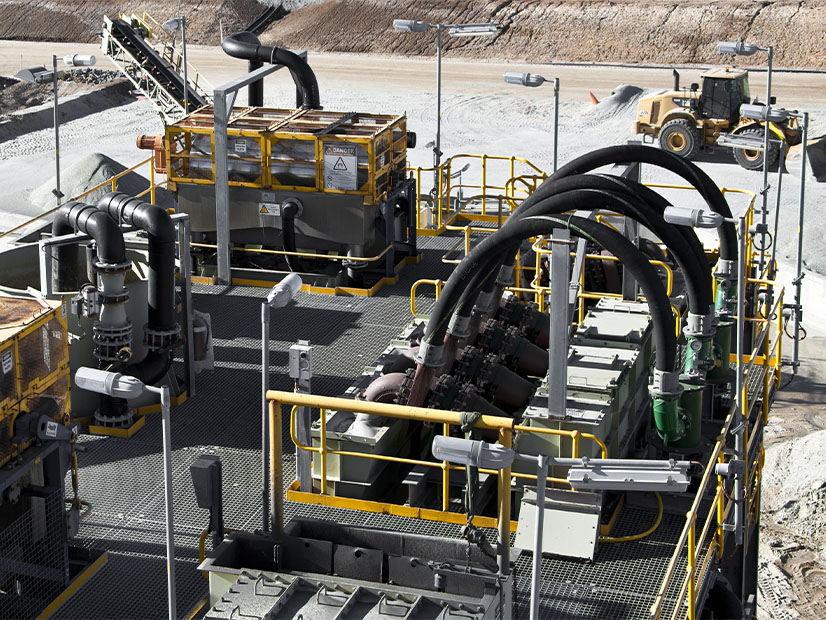The U.S. Department of Energy is consolidating its portfolio of critical mineral research and development programs in a bid to build a domestic supply chain of materials needed to decarbonize the national economy.
The new, wide-ranging Critical Materials Research, Development, Demonstration and Commercialization Application (RDD&CA) program will be funded with $675 million from the Infrastructure Investment and Jobs Act (IIJA).
In a request for information released Tuesday, the DOE said the program with the tongue-twisting abbreviation would “integrate, expand and accelerate DOE’s strategy to build resilient, diverse, sustainable and secure domestic supply chains that support the clean energy transition and decarbonize energy, industrial, manufacturing and transportation sectors while promoting safe, sustainable, economic and environmentally just solutions to meet current and future needs.”
According to the RFI, the RDD&CA program was authorized in the Energy Act of 2020, the bipartisan package passed in December of that year. The funding in the IIJA includes $600 million to be used over four years to promote critical materials recycling, innovation, efficiency and alternatives. Another $75 million will provide two years of funding for the development of a Critical Material Supply Chain Research Facility, also authorized by the Energy Act.
The projects using this combined funding will “make our nation more secure by increasing our ability to source, process and manufacture critical materials right here at home,” Energy Secretary Jennifer Granholm said in a press release announcing the RFI. “The [IIJA] is supporting DOE’s effort to invest in the building blocks of clean energy technologies, which will revitalize America’s manufacturing leadership.”
U.S. dependence on China and other foreign sources for the critical minerals needed for a range of clean technologies — for example, the lithium-ion batteries used in electric vehicles — has long been an easy target for Republican critics of President Biden’s clean energy goals. According to DOE, global demand for critical materials in general could grow by 400 to 600% over the next several decades, while demand for lithium and graphite, also used in EV batteries, could increase by as much as 4,000%.
China controls up to 80% of lithium refining capacity and 60% of battery component manufacturing, according to figures from BloombergNEF.
The need for building out a domestic supply chain for these critical materials has also provided an opportunity for bipartisan agreement — such as the funding for the RDD&CA in the IIJA.
An additional $140 million in the law is being used to support the development of “a new facility to demonstrate the commercial feasibility of a full-scale rare earth element and critical minerals extraction and separation refinery using unconventional resources,” such as coal waste and ash and acid mine drainage. An RFI for that project was released in February.
Critical mineral supply chains could also get a boost from advanced manufacturing credits in the Inflation Reduction Act, passed by the Senate on Sunday and now awaiting a vote in the House of Representatives. Battery cells and modules are eligible for credits of $10 to $35 per kWh of capacity, and a range of critical minerals will be able to take a 10% tax credit on their production costs.
In 5 Years
The DOE defines critical materials “based on [their] importance to a range of energy technologies and the potential for supply risk,” the RFI says.
The Critical Material RDD&CA will take a “material-by-material approach,” prioritizing the following minerals:
-
-
- neodymium, praseodymium and dysprosium, used for magnets in wind turbines and electric and fuel cell vehicle motors;
- lithium, cobalt, nickel, graphite and manganese, used for lithium-based batteries needed for energy storage;
- platinum group metals used for catalytic converters in fuel cells and in electrolyzers for green hydrogen production;
- gallium, used for light emitting diodes and wide bandgap power electronics in high voltage power generation;
- germanium, used for microchips needed for sensors, data and control in smart manufacturing.
-
The new initiative will also be based on DOE’s core “pillars” for supply chain buildout, which include diversifying and expanding domestic critical mineral supplies, developing substitutes and promoting efficiency across the supply chain, as well as a circular economy approach to repair, reuse, recycling and remanufacturing.
The RFI lays out tentative program priorities for each of the critical mineral groups. For example, DOE envisions a range of research and development activities, pilots and demonstration projects for all aspects of the supply chain for neodymium, praseodymium and dysprosium, from mining and processing to recycling. A tighter focus is used for lithium, cobalt and other key battery minerals, with R&D and pilots planned only for mining, extraction and coproduction, in which multiple materials are produced together and bring in similar revenue streams.
DOE is looking for input and ideas on how best to organize and execute the program, with comments due by Sept. 9. The RFI includes a range of questions, from what criteria should be used to measure program success, to concerns about “the ideal timing and desirable features, terms and conditions of off-take agreements that would stimulate the private sector investment necessary” to achieve program goals.
Questions also focus on community benefits and engagement, including job creation, labor standards and workforce training, especially in disadvantaged and low-income communities.
How long it will take to develop a domestic supply chain for critical minerals is also a core concern. “What are the most high-impact opportunities to diversify supply, develop substitutes, increase material and manufacturing efficiency and drive reuse and recycle of critical materials for energy technologies … in the next 5 years?” the DOE asks. “What quantitative impact could the Critical Materials RDD&CA program have on domestic supply chains in 5 years?”




